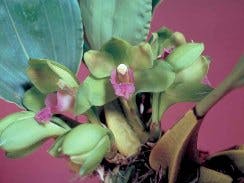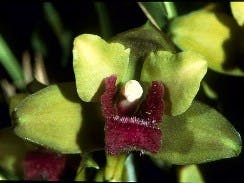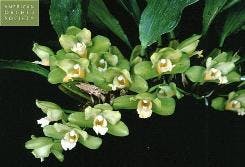Bifrenaria inodora Sander

Bifrenaria inodora 'Gale', CBM/AOS
This beautiful little Brazilian jewel is flowering now (May). It, along with some 20 other species in Bifrenaria belongs to the Maxillaria tribe. While it should be theoretically possible to create hybrids with other genera in this tribe, very little has been done and the only intergeneric hybrids of Bifrenaria are those with Lycaste (Lycastenaria). Bifrenarias, especially Bifrenaria inodora, are scarce in cultivation, though their attractive flowers and ease of cultivation should make them much better known to collectors.

Bifrenaria Jane Ann Cook 'Carsyn Elise' AM/AOS
These plants are sympodial epiphytes or terrestrials. Their 5-7 cm (2-3”) pseudobulbs are distinctly conical and strongly four-angled. Each pseudobulb is topped by a single short-stalked somewhat leathery, pleated leaf up to 30cm long (12”). The inflorescences, as is characteristic of the genus, are produced from the base of the pseudobulb matured last year and carry one or two long-lasting flowers up to 7.5cm (3”) across. While there's very little variation in the green color of the sepals and petals, the lip can vary from white to yellow and even a light rose. The only thing this beautiful species is missing is fragrance. Unlike Bifrenaria harrisoniae whose fragrance can be overpowering, Bifrenaria inodora commonly has no fragrance (the name inodora means “without fragrance”).

Bifrenaria inodora 'Cardinal's Roost' CCM/AOS
Plants are easily grown in intermediate conditions, with good light and high humidity. Their basic requirements are very similar to the warm-growing Lycastes and they should be much more common in cultivation than they are. They flower best if pot-bound and resent having their roots disturbed so they should be repotted only when it is absolutely necessary to avoid stale conditions at the roots. Any good epiphytic mix will work well for these plants as long as it doesn't break down too rapidly. While in active growth, they should be given as much water and humidity as possible without decomposing the potting mix. Once growth is completed, they should be kept drier for several weeks with occasional misting and only enough water to keep the pseudobulbs from wrinkling. During this dry rest period, they can be kept in slightly cooler temperatures.Orchid Digest 41: 205-208.









